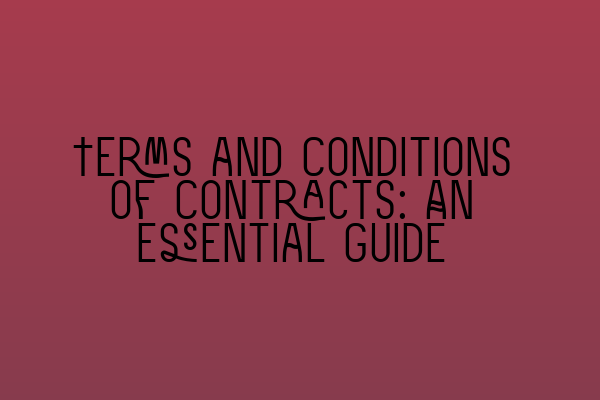In the world of contract law, terms and conditions play a crucial role in protecting the interests of all parties involved. Whether you are a business owner entering into a contract with a supplier, a freelancer working with a client, or even an individual purchasing a product or service, understanding the terms and conditions of a contract is essential. In this comprehensive guide, we will explore the importance of terms and conditions in contracts and provide you with the information you need to ensure that your contracts are fair, enforceable, and protect your rights.
What are Terms and Conditions?
Before we dive into the intricacies of terms and conditions, let’s start with the basics. Terms and conditions, also known as T&Cs, are the legal provisions and guidelines that govern the rights and obligations of all parties involved in a contract. They define the scope of the contract, the expectations of each party, and the remedies available if any party fails to fulfill their obligations.
Terms and conditions can cover a wide range of aspects, including but not limited to:
- Payment terms
- Delivery terms
- Warranty and liability provisions
- Intellectual property rights
- Termination clauses
As the backbone of a contract, terms and conditions provide clarity and certainty to all parties. They outline the rules of the game and help prevent misunderstandings, disputes, and potential legal issues.
The Importance of Well-Drafted Terms and Conditions
Having clear and well-drafted terms and conditions is of utmost importance for several reasons:
1. Legal Protection: Terms and conditions provide legal protection by clearly stating the rights and obligations of each party. If a dispute arises, well-drafted terms and conditions can help resolve the issue quickly and in favor of the party that has adhered to the terms.
2. Risk Mitigation: Well-drafted terms and conditions can help mitigate risks by addressing potential issues before they occur. For example, including a clause that limits liability or specifies the procedure for resolving a dispute can protect you from costly litigation.
3. Clarity and Transparency: Terms and conditions ensure clarity and transparency in the contractual relationship. By clearly outlining the expectations and requirements, both parties can align their actions and avoid any misunderstandings.
4. Flexibility and Adaptability: Terms and conditions can be tailored to specific needs and circumstances. This allows parties to negotiate and include provisions that are specific to their industry, business model, or individual requirements.
Now that we have established the importance of well-drafted terms and conditions, let’s explore some key elements that should be included in every contract.
Key Elements of Terms and Conditions
1. Clear and Concise Language: Terms and conditions should be written in clear and concise language that is easily understandable by all parties involved. Avoid using jargon or complex legal terms that may confuse or mislead the reader.
2. Definitions: Define key terms and concepts used throughout the contract to avoid ambiguity and ensure common understanding.
3. Scope and Purpose: Clearly state the purpose and scope of the contract. This includes defining the products, services, or obligations being exchanged between the parties.
4. Obligations and Responsibilities: Specify the obligations and responsibilities of each party. This includes outlining payment terms, delivery timelines, quality standards, and any other relevant obligations.
5. Intellectual Property Rights: Address intellectual property rights, including ownership and usage rights of any inventions, trademarks, copyrights, or trade secrets involved in the contract.
6. Termination and Suspension: Include provisions that outline the circumstances and procedures for terminating or suspending the contract. This provides clarity and guidance in the event that one party wants to end the contractual relationship.
7. Dispute Resolution: Specify the procedure for resolving disputes that may arise during the course of the contract. This can include options such as mediation, arbitration, or litigation.
8. Amendments and Waivers: Include provisions that address how and when the contract can be amended and any waivers or exemptions to certain provisions.
These are just a few key elements that should be considered when drafting terms and conditions. However, every contract is unique, and it is important to consult with a solicitor to ensure that all relevant provisions are included.
Enforceability of Terms and Conditions
For terms and conditions to be enforceable, certain requirements must be met:
- Consent: All parties must voluntarily and knowingly agree to the terms and conditions. This can be achieved through written acceptance, electronic acceptance, or implied acceptance through actions.
- Fairness: The terms and conditions must be fair and reasonable. Any provision found to be unfair or unreasonable may be deemed unenforceable by a court of law.
- Transparency: The terms and conditions should be easily accessible to all parties involved. They should not contain hidden or misleading clauses.
It is worth noting that there are certain statutory provisions that may override or limit certain terms and conditions, particularly consumer contracts. In such cases, it is important to ensure compliance with relevant laws and regulations.
Conclusion
Terms and conditions serve as the foundation of a contract, providing clarity, protection, and guidance for all parties involved. By understanding the importance of well-drafted terms and conditions and incorporating key elements into your contracts, you can safeguard your rights, mitigate risks, and foster a strong and transparent business relationship.
For more insights into the legal profession and related topics, check out these articles:
- Barrister vs. Solicitor: A Comprehensive Comparison
- Exploring Different Solicitor Specializations: Finding Your Niche
- Embracing the Rise of Virtual Law Practices
- Navigating the Maze: Demystifying Ethical Responsibilities of Solicitors
- Unveiling Real-Life Case Studies: Insights into Legal Practice and Decision-Making
